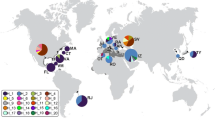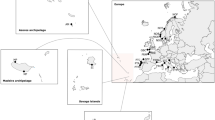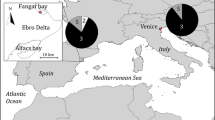Abstract
A strongly divergent lineage, putatively a new cryptic species, of colonial ascidian was first detected as an anomalous sample in a population genomics study of the well-known worldwide invasive species Didemnum vexillum Kott, 2002. This putative new taxon, found in a marina in Roscoff, France, is indistinguishable from Didemnum vexillum in the external aspect and coexists with it in syntopy. However, morphological characters such as spicules and larvae allow a clear-cut distinction. In accordance with the preliminary results based on genome-wide analyses, morphological traits and mitochondrial sequences of the cytochrome oxidase I gene both support the establishment of a new species Didemnum pseudovexillum sp. nov. Previous unidentified sequences in public databases showed that the new species is also present in NW Mediterranean marinas. Didemnum pseudovexillum sp. nov. is assigned for the time being a cryptogenic species status, although its presently known disjoint distribution across two biogeographic regions and its presence in ports are suggestive of an introduced species. Further studies should be performed to ascertain its current distribution and putative natural range and settle its native vs. non-native status. This finding casts doubts on previous reports of Didemnum vexillum and also calls for caution when performing fast field surveys of non-indigenous species such as rapid assessment surveys (RAS) or BioBlitz surveys, based solely on external characters.





Similar content being viewed by others
References
Bishop JDD, Roby C, Yunnie ALE, Wood CA, Lévêque L, Turon X, Viard F (2013) The Southern Hemisphere ascidian Asterocarpa humilis is unrecognised but widely established in NW France and Great Britain. Biol Invasions 15:253–260
Bishop JD, Wood CA, Yunnie AL, Griffiths CA (2015) Unheralded arrivals: non-native sessile invertebrates in marinas on the English coast. Aquat Invasions 10:249–264
Bock DG, MacIsaac HJ, Cristescu ME (2012) Multilocus genetic analyses differentiate between widespread and spatially restricted cryptic species in a model ascidian. Proc R Soc B 279:2377–2385
Bortolus A (2008) Error cascades in the biological sciences: the unwanted consequences of using bad taxonomy in ecology. AMBIO 37:114–118
Brunetti R, Gissi C, Pennati R, Caicci F, Gasparini F, Manni L (2015) Morphological evidence indicates that Ciona intestinalis (Tunicata, Ascidiacea) type A and type B are different species: Ciona robusta and Ciona intestinalis. J Zool Syst Evol Res 53:186–193
Brunetti R, Griggio F, Mastrototaro F, Gasparini F, Gissi C (2020) Toward a resolution of the cosmopolitan Botryllus schlosseri species complex (Ascidiacea, Styelidae): mitogenomics and morphology of clade E (Botryllus gaiae). Zool J Linnean Soc zlaa023. https://doi.org/10.1093/zoolinnean/zlaa023
Campbell ML, Gould B, Hewitt CL (2007) Survey evaluations to assess marine bioinvasions. Mar Pollut Bull 55:360–378
Carlisle DB (1954) Styela mammiculata n.sp., a new species of ascidian from the Plymouth area. J. Mar. biol. Ass. UK 33:329–334
Carlton JT (1996) Biological invasions and cryptogenic species. Ecology 77:1653–1655
Carlton JT (1999) The scale and ecological consequences of biological invasions in the world’s oceans. In: Sandlund OT, Schei PJ, Viken Å (eds) Invasive species and biodiversity management. Kluwer Academic Publishers, Dordrecht, pp 195–212
Carlton JT (2009) Deep invasion ecology and the assembly of communities in historical time. In: Rilov G, Crooks JA (eds) Biological invasions in marine ecosystems. Springer-Verlag, Berlin Heidelberg, pp 13–56
Carman MR, Morris JA, Karney RC, Grunden DW (2010) An initial assessment of native and invasive tunicates in shellfish aquaculture of the North American east coast. J Appl Ichthyol 26:8–11
Casso M, Turon X, Pascual M (2019) Single zooids, multiple loci: independent colonisations revealed by population genomics of a global invader. Biol Invasions 21:3575–3592
Casso M, Turon M, Marco N, Pascual M, Turon X (2020) The microbiome of the worldwide invasive ascidian Didemnum vexillum. Front Mar Sci 7:201. https://doi.org/10.3389/fmars.2020.00201
Cohen AN, Harris LH, Bingham BL, Carlton JT, Chapman JW, Lambert CC, Lambert G, Ljubenkov JC, Murray SN, Rao LC, Reardon K, Schwindt E (2005) Rapid assessment survey for exotic organisms in southern California bays and harbors, and abundance in port and non-port areas. Biol Invasions 7:995–1002
Cohen AN, McCann L, Davis T, Shaw L, Ruiz G (2011) Discovery and significance of the colonial tunicate Didemnum vexillum in Alaska. Aquat Invasions 6:263–271
Comtet T, Sandionigi A, Viard F, Casiragi M (2015) DNA (meta)barcoding of biological invasions: a powerful tool to elucidate invasion processes and help managing aliens. Biol Invasions 17:905–922
Dias PJ, Rocha R, Godwin S, Tovar-Hernández MA, Delahoz MV, McKirdy S, de Lestang P, McDonaid JI, Snow M (2016) Investigating the cryptogenic status of the sea squirt Didemnum perlucidum (Tunicata, Ascidiacea) in Australia based on a molecular study of its global distribution. Aquat Invasions 11:239–245
Erwin PM, Pineda MC, Webster N, Turon X, López-Legentil S (2014) Down under the tunic: bacterial biodiversity hotspots and widespread ammonia-oxidizing archaea in coral reef ascidians. ISME J 8:575–588
Ezard T,Fujisawa T, Barraclough TG. 2009. SPLITS: SPecies’ LImits by threshold statistics. R package version 1.0-18/r45, 2009. http://R-Forge.R-project.org/projects/splits/. Accessed 14 Jan 2020
Giangrande A (2003) Biodiversity, conservation, and the ‘taxonomic impediment’. Aquat Conserv 13:451–459.
Grey EK (2009) Do we need to jump in? A comparison of two survey methods of exotic ascidians on docks. Aquat Invasions 4:81–86
Griggio F, Voskoboynik A, Iannelli F, Justy F, Tilak MK, Turon X, Pesole G, Douzery EJP, Mastrototaro F, Gissi C (2014) Ascidian mitogenomics: comparison of evolutionary rates in closely related taxa provides evidence of ongoing speciation events. Genome Biol Evol 6:591–605
Hall TA (1999) BioEdit: a user-friendly biological sequence alignment editor and analysis program for Windows 95/98/NT. Nucl Acids Symp Ser 41:95–98
Hartmeyer R (1909) Ascidien (continuation of work by Seeliger). In: Bronn HG (ed) Klassen und Ordnungen des Tier-Reichs. CF Winter’sche Verlagshandlung, Leipzig
Heller C (1878) Beiträge zur nähern Kenntnis der Tunicaten. Sitzber Acad Wiss Wien 77:2–28
Herdman WA (1880) Preliminary report on the Tunicata of the Challenger expedition. Part 2. Proc R Soc Edinburgh 10(2):714–726
Herdman WA (1881) Preliminary report on the Tunicata of the Challenger expedition. Cynthiidae Proc Roy Soc Edinburgh 11(3):52–88
Kakkonen JE, Worsfold TM, Ashelby CW, Taylor A, Beaton K (2019) The value of regular monitoring and diverse sampling techniques to assess aquatic non-native species: a case study from Orkney. Manag Biol Invasion 10:46–79
Kapli T, Lutteropp S, Zhang J, Kobert K, Pavlidis P, Stamatakis A, Flouri T (2016) Multi-rate Poisson tree processes for single-locus species delimitation under maximum likelihood and Markov chain Monte Carlo. Bioinformatics 33:1630–1638
Kott P (1985) The Australian Ascidiacea. Part 1, Phlebobranchia and Stolidobranchia. Mem Qd Mus 23:1–440
Kott P (2001) The Australian Ascidiacea. Part 4, Aplousobranchia (3), Didemnidae. Mem Qd Mus 47:1–407
Kott P (2002) A complex didemnid ascidian from Whangamata, New Zealand. J Mar Biol Ass UK 82:625–628
Kott P (2004a) A new species of Didemnum (Ascidiacea, Tunicata) from the Atlantic coast of North America. Zootaxa 732:1–10
Kott P (2004b) New and little-known species of Didemnidae (Ascidiacea, Tunicata) from Australia (part 1). J Nat Hist 38:731–774
Kumar S, Stecher G, Tamura K (2016) MEGA7: molecular evolutionary genetics analysis version 7.0 for bigger datasets. Mol Biol Evol 33:1870–1874
Lafargue F, Wahl M (1987) The didemnid ascidian fauna of France. Ann Inst océanogr, Paris 63:1–46
Lambert G (2007) Invasive sea squirts: a growing global problem. J Exp Mar Biol Ecol 342:3–4
Lambert G (2009) Adventures of a sea squirt sleuth: unraveling the identity of Didemnum vexillum, a global ascidian invader. Aquat Invasions 4:5–28
Lambert G (2019) Fouling ascidians (Chordata: Ascidiacea) of the Galapagos: Santa Cruz and Baltra Islands. Aquat Invasions 14:132–149
Linnaeus C (1767) Systema naturae per regna tria naturae: secundum classes, ordines, genera, species, cum characteribus, differentiis, synonymis, locis. Ed. 12. 1., Regnum Animale. 1 & 2. Holmiae, Laurentii Salvii. Holmiae Stockholm, Laurentii Salvii. pp 533–1327
López-Legentil S, Turon X (2005) How do morphotypes and chemotypes relate to genotypes? The colonial ascidian Cystodytes (Ascidiacea: Polycitoridae). Zool Scripta 34:3–14
López-Legentil S, Turon X, Planes S (2006) Genetic structure of the star sea squirt, Botryllus schlosseri, introduced in southern European harbours. Mol Ecol 15:3957–3967
López-Legentil S, Legentil ML, Erwin PM, Turon X (2015) Harbor networks as introduction gateways: contrasting patterns of native and introduced ascidians. Biol Invasions 17:1623–1638
Malfant M, Darras S, Viard F (2018) Coupling molecular data and experimental crosses sheds light about species delineation: a case study with the genus Ciona. Sci Rep 8:1480
Millar RH (1960) The identity of the ascidians Styela mammiculata Carlisle and S. clava Herdman. J. Mar. biol. Ass. UK 39:509–511
Milne Edwards H (1841) Observations sur les ascidies composées des côtes de la Manche. Mem Acad Sci Paris 18:217–326
Monniot F (1983) Ascidies littorals de Guadeloupe. I. Didemnidae. Bull Mus natn Hist nat, Paris, 4e Sér. 16, Section A, 1:5–49
Monniot F (1995) Ascidies de Nouvelle-Calédonie. XV. Le genre Didemnum. Bull Mus natn Hist nat, Paris, 4e Sér. 5, Section A, 2-4:299–344
Monniot F (2016) Ascidians (Tunicata) of the French Guiana expedition. Zootaxa 4114:201–245
Monniot C, Monniot F (1994) Additions to the inventory of Eastern tropical Atlantic ascidians: arrival of cosmopolitan species. Bull Mar Sci 54:71–93
Monniot C, Monniot F, Griffiths CL (2001) South African ascidians. Ann S African Mus 108:1–141
Nall CR, Guerin AJ, Cook EJ (2015) Rapid assessment of marine non-native species in northern Scotland and a synthesis of existing Scottish records. Aquat Invasions 10:107–121
Neves IM (2015) Didemnidae ascidians (Tunicata, Ascidiacea) from Bocas del Toro – Panamá. PhD Thesis Dissertation, Universidade Federal do Paraná
Ojaveer H, Galil BS, Gollasch S, Marchini A, Minchin D, Occhipinti-Ambrogi A, Olenin S (2014) Identifying the top issues of marine invasive alien species in Europe. Management of Biol Invasions 5:81–84
Oka A (1927) Zur Kenntnis der japanischen Botryllidae (Vorläufige Mitteilung). Proc Imp Acad 3:607–609
Oliveira FAS, Michonneau F, Lotufo TMC (2017) Molecular phylogeny of Didemnidae (Ascidiacea: Tunicata). Zool J Linnean Soc 180:603–612
Ordóñez V, Pascual M, Fernández-Tejedor M, Pineda MC, Tagliapietra D, Turon X (2015) Ongoing expansion of the worldwide invader Didemnum vexillum (Ascidiacea) in the Mediterranean Sea: high plasticity of its biological cycle promotes establishment in warm waters. Biol Invasions 17:2075–2085
Ordóñez V, Pascual M, Fernández-Tejedor M, Turon X (2016) When invasion biology meets taxonomy: Clavelina oblonga (Ascidiacea) is an old invader in the Mediterranean Sea. Biol Invasions 18:1203–1215
Pallas PS (1766) Elenchus zoophytorum sistens generum adumbrationes generaliores et specierum cognitarum succintas descriptiones, cum selectis auctorum synonymis. Fransiscum Varrentrapp, Hagae
Pante E, Puillandre N, Viricel A, Arnaud-Haond S, Aurelle D, Castelin M, Chenuil A, Destombe C, Forcioli D, Valero M, Viard F, Samadi S (2015a) Species are hypotheses: avoid connectivity assessments based on pillars of sand. Mol Ecol 24:525–544
Pante E, Abdelkrim J, Viricel A, Gey D, France SC, Boisselier MC, Samadi S (2015b) Use of RAD sequencing for delimiting species. Heredity 114:450–459
Pentinsaari M, Vos R, Mutanen M (2017) Algorithmic single-locus species delimitation: effects of sampling effort, variation and nonmonophyly in four methods and 1870 species of beetles. Mol Ecol Resour 17:393–404
Pérez-Portela R, Arranz V, Rius M, Turon X (2013) Cryptic speciation or global spread? The case of a cosmopolitan marine invertebrate with limited dispersal capabilities. Sci Rep 3:3197
Pons J, Barraclough TG, Gomez-Zurita J, Cardoso A, Duran DP, Hazell S, Kamoun S, Sumlin WD, Vogler AP (2006) Sequence-based species delimitation for the DNA taxonomy of undescribed insects. Syst Biol 55:595–609
Puillandre N, Lambert A, Brouillet S, Achaz G (2012) ABGD, Automatic Barcode Gap Discovery for primary species delimitation. Mol Ecol 21:1864–1877
Ratnasingham S, Hebert PDN (2013) A DNA-based registry for all animal species: the Barcode Index Number (BIN) system. PLoS One 8:e66213
Ritter WE, Forsyth RH (1917) Ascidians of the littoral zone of southern California. Univ California Publ Zool 16:439–512
Rocha RM, Bonnet NYK (2009) Ascidias (Tunicata, Ascidiacea) introduzidas no Arquipélago de Alcatrazes, Sao Paulo. Iheringia, Sér Zool, Porto Alegre 99:27–35
Salfi M (1929) Sulla blastogenesi in Clavelina e su una nuova specie del genere. Pub Staz Zool Napoli 9:195–201
Savigny JC (1816) Mémoires sur les animaux sans vertèbres, seconde partie. CLF Panckoucke, Paris
Schliep KP (2011) phangorn: phylogenetic analysis in R. Bioinformatics 27:592–593
Shenkar N, Swalla BJ (2011) Global diversity of Ascidiacea. PLoS One 6:e20657
Shenkar N, Gittenberger A, Lambert G, Rius M, Rocha R, Swalla BJ, Turon X (2019) Ascidiacea World Database. http://www.marinespecies.org/ascidiacea. Accessed 12 Dec 2019
Sluiter CP (1895) Tunicaten. In: Semon R (ed). Zoologische Forschungsreisen in Australien und den malagischen Archipel. Denkschr. Gesellsch, Jena 8:163–186
Sluiter CP (1898) Tuniciers recueillis en 1896 par la Chazalie dans la mer des Antilles. Mem Soc Zool France 11:5–34
Sluiter CP (1909) Die Tunicaten der Siboga-Expedition. Part 2. Die merosomen Ascidien. Siboga-Expedition 56:1–112
Smale DA, Childs S (2012) The occurrence of a widespread marine invader, Didemnum perlucidum (Tunicata, Ascidiacea) in Western Australia. Biol Invasions 14:1325–1330
Stefaniak L, Lambert G, Gittenberger A, Zhang H, Lin S (2009) Genetic conspecificity of the worldwide populations of Didemnum vexillum Kott, 2002. Aquat Invasions 4:29–44
Stefaniak L, Zhang H, Gittenberger A, Smith K, Holsinger K, Lin S, Whitlatch RB (2012) Determining the native region of the putatively invasive ascidian Didemnum vexillum Kott, 2002. J Exp Mar Biol Ecol 422–423:64–71
Tamura K, Battistuzzi FU, Billing-Ross P, Murillo O, Filipski A, Kumar S (2012) Estimating divergence times in large molecular phylogenies. PNAS 109:19333–19338
Teske PR, Rius M, McQuaid CD, Styan CA, Piggott MP, Benhissoune S, Fuentes-Grünewald C, Walls K, Page M, Attard CRM, Cooke GM, McClusky CF, Banks SC, Barker NP, Beheregaray LB (2011) “Nested” cryptic diversity in a widespread marine ecosystem engineer: a challenge for detecting biological invasions. BMC Evol Biol 11:1–13
Turon X, Tarjuelo I, Duran S, Pascual M (2003) Characterising invasion processes with genetic data: an Atlantic clade of Clavelina lepadiformis (Ascidiacea) introduced into Mediterranean harbours. Hydrobiologia 503:29–35
Viard F, Roby C, Turon X, Bouchemousse S, Bishop J (2019) Cryptic diversity and database errors challenge non-indigenous species surveys: an illustration with Botrylloides spp. in the English Channel and the Mediterranean Sea. Front Mar Sci 6:615. https://doi.org/10.3389/fmars.2019.00615
Villesen P (2007) FaBox: an online toolbox for fasta sequences. Mol Ecol Res 7:965–968
Zhan A, Briski E, Bock DG, Ghabooli S, MacIsaac HJ (2015) Ascidians as models for studying invasion success. Mar Biol 162:2449–2470
Acknowledgments
We are grateful to Laurent Lévêque and the diving team (Mathieu Camusat, Yann Fontana, Wilfried Thomas) of the Marine & Diving Facilities of the FR2424 - Station Biologique de Roscoff, for the field sampling. We thank Andrea Fernández and Gustavo Carreras for help with the sequencing work. The comments of three anonymous reviewers helped to improve the article. All necessary authorizations for field sampling by diving in Roscoff were given by decisions of the Prefect of the Brittany Region (Decision 85/2015 of 18/02/2015 and Decision 154/2018 of 02/02/2018).
Funding
This research was funded by the project PopCOmics (CTM2017-88080, MCIU/AEI/FEDER/UE) from the Spanish Government. Additional support for sampling and surveys in Brittany came from the AquaNIS2.0 project, supported by the Foundation TOTAL. This is a contribution from the Consolidated Research Group “Benthic Biology and Ecology” SGR2017-1120 (Catalan Government).
Author information
Authors and Affiliations
Corresponding author
Ethics declarations
Conflict of interest
The authors declare that they have no conflict of interest.
Ethical approval
All applicable international, national, and/or institutional guidelines for animal testing, animal care, and use of animals were followed by the authors.
Sampling and field studies
All necessary permits for sampling have been obtained by the authors from the competent authorities and are mentioned in the “Acknowledgments”. This study is compliant with CBD and Nagoya protocols.
Data availability
The sequences obtained in this study have been deposited in GenBank with accession numbers MN952978–80. All datasets analysed during this study are included as supplementary information files.
Author contributions
XT and FV conceived the research. FV contributed samples. MC and MP generated and analysed genetic data, with contribution from FV and XT. XT analysed morphological details and wrote the first draft of the manuscript. All authors contributed to the manuscript and approved its contents.
Additional information
Communicated by K. Kocot
Publisher’s note
Springer Nature remains neutral with regard to jurisdictional claims in published maps and institutional affiliations.
This article is registered in ZooBank under http://zoobank.org/A10F8027-8DB8-46EB-8F2F-BB1E8CD4468D
Rights and permissions
About this article
Cite this article
Turon, X., Casso, M., Pascual, M. et al. Looks can be deceiving: Didemnum pseudovexillum sp. nov. (Ascidiacea) in European harbours. Mar. Biodivers. 50, 48 (2020). https://doi.org/10.1007/s12526-020-01083-7
Received:
Revised:
Accepted:
Published:
DOI: https://doi.org/10.1007/s12526-020-01083-7




